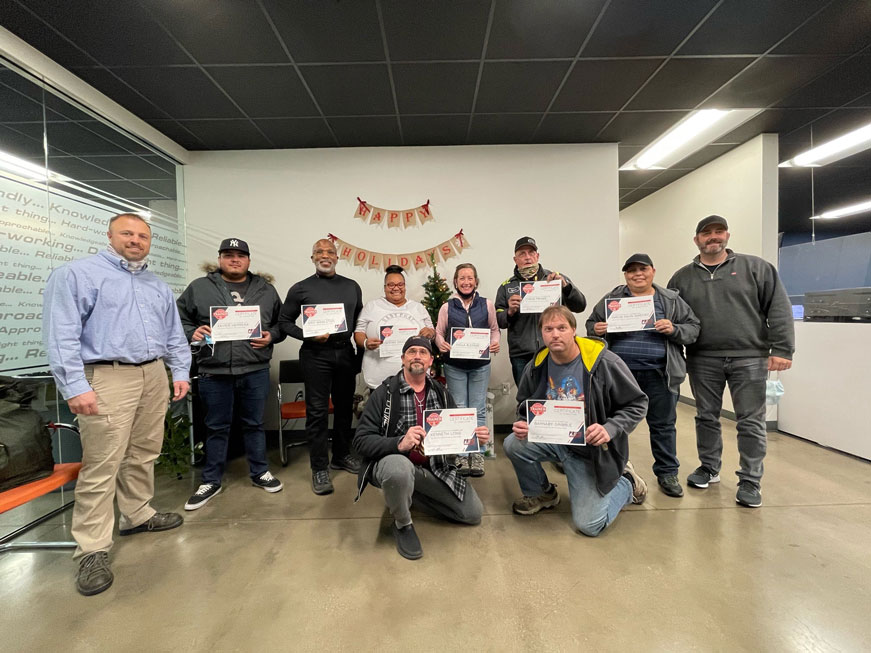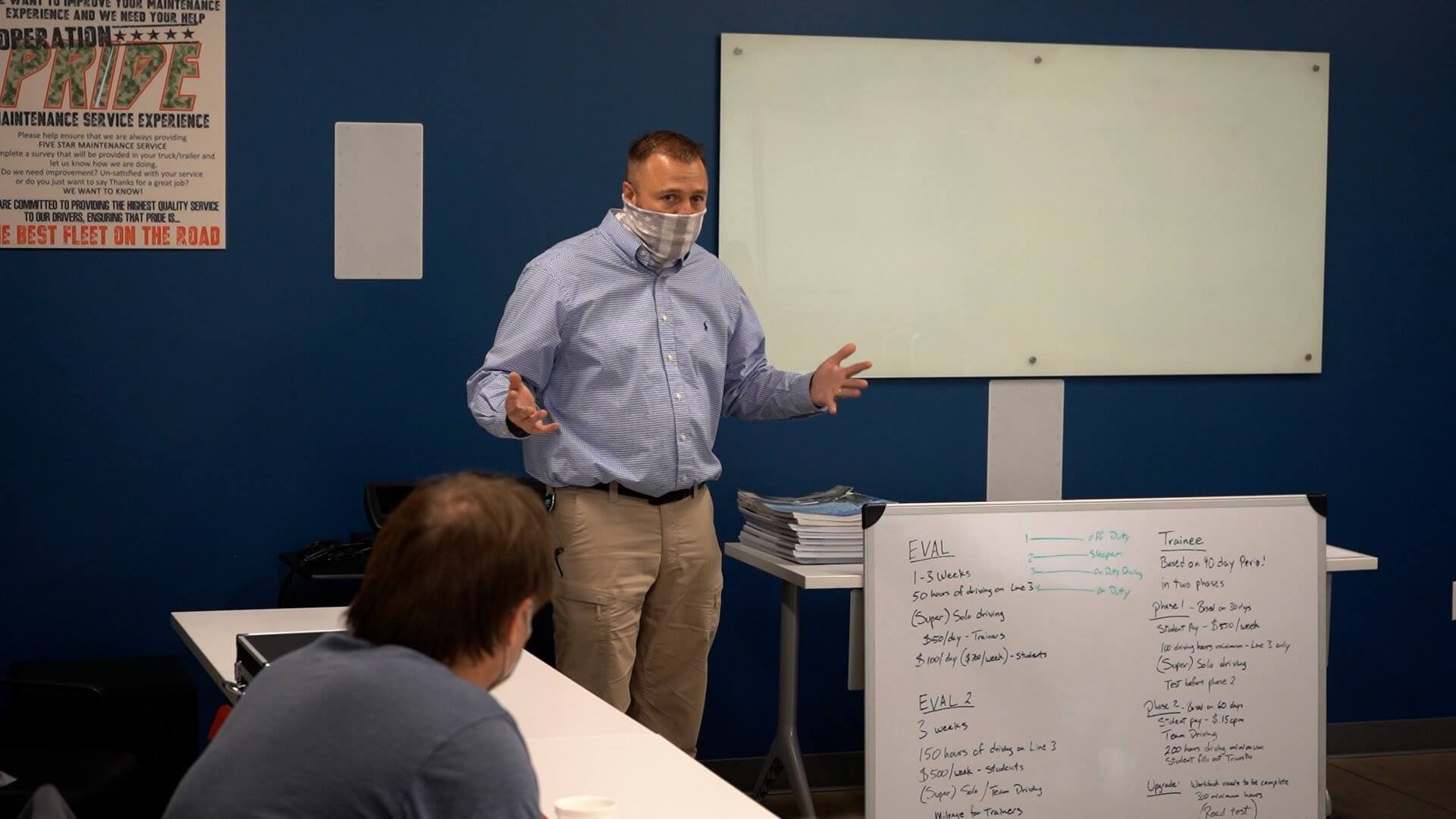by Pride Transport | Feb 10, 2021
If you have your CDL, then you’ve been through some training, and for most companies, that’s enough. They’ll drop you behind the wheel of a truck and send you on your merry way. Good luck on the open road; see you when your route is done. That’s okay for some, but that is certainly not okay when you drive with Pride Transport.
At Pride, there is a distinct difference between training and preparedness. At Pride, the words are safely- prepared. It’s more than just training. It’s practical knowledge, first-hand experience, and the tools you will need to not only do the job but, but to be both safe and successful in the career.
Pride will train you to do all that a driver has to do, but they will give you more. They will provide you with a clear picture of what life on the road, in a truck, safely driving the highways of this country, is actually like.
Pride is built on honesty. They say what they mean, and they speak the truth. All employees at Pride know that what they’re told is the truth, and there is never any question about it. So, with Pride, you’re going to see the truth about what being a driver is like. The good, the bad, the hard and fun stuff, and most importantly, the rewarding stuff.
Pride approaches training with the same dedication to truth, the same goal of making all their drivers successful as they do all aspects of the work. With Pride, you know you’re hitting the road not only safe and properly trained, but well prepared too. This is a lifestyle.
Trainers


It’s a fact that when a student has a good teacher, a dedicated teacher, one who cares about their students learning, retaining, and employing information in the “classroom,” that the student excels. The same goes for drivers and driving trainers.
Great trainers don’t just pop into existence. They are forged from years of experience, a keen understanding of life on the road, and an ability to listen and translate what a student says and does, into practical information they need to succeed. Not every good driver can be a good trainer. There is a sensibility that is necessary to convey information in a clear and impactful manner.
To be a trainer with Pride, a driver has to pass an intensive and thorough interview process. They must display a true exemplification of Pride’s core values; safety-minded, knowledgeable, hard-working, friendly and approachable, and always doing the right thing. These trainers are, in essence, safety trainers, making sure new drivers or drivers looking for a refresh after time away, always have safety in the forefront of their minds. Those who are chosen to be trainers are, frankly, the best of the best.
But, before becoming a trainer, a driver must go through Pride’s train the trainer program.
The Program

Just because you can do a task well doesn’t mean you can teach others how to do it. Teaching is not easy at all. Think about something you do all the time, day in, day out. By now, it’s become habitual. You just know how to do it. There’s no thought process involved, or rather, the thought process has become so ingrained that you overlook the individual components that go into doing the task.
An excellent trainer has to have the ingrained feeling for the work and share it with a student in a coherent, easy to follow way, tailoring their training style to the individual student. Putting the task that you know so well into words and informative actions is where it gets tricky, and that’s what makes for a great trainer.
Those who apply to the program and show the needed qualities will be accepted and trained to be trainers. In fact, a good number of our trainers didn’t apply on their own, the company reached out to them, based on their performance, behavior and exemplification of The Pride Way, our company’s culture.
The trainer program will teach the following:
The process behind the student and trainer partnership
This is important. There is a teacher, and there is a student; however, they are working in a partnership. Even though one has more experience, it doesn’t mean they can command or rule over the student. How to work with a new driver, how to speak to them, give them advice and correct them when they make mistakes, and take a confident attitude. Often, how a student is taught will indicate how they treat other drivers, customers, and, if they want to, the people they go on to train. Understanding and fostering that partnership is vital to producing sound, safe, professional Pride drivers.
How to go over the rules of the truck and promote a safe, inviting atmosphere on the truck before they get started
Being familiar and comfortable with the truck is going to serve the driver well, down the line. It’s more than just listing the rules. We learn better when there are reasons and examples. A good trainer learns to teach the rules and the why behind them. The why is where the trainer gets to solidify the need for safety. Also, knowing the rules and the why of them removes the mystery and makes things more tangible and manageable. Let’s face it; a truck is a powerful machine. And a fully loaded trailer can run 80,000 pounds. That can be intimidating. A good trainer removes the intimidation, replaces it with respect and knowledge, and makes the truck an inviting place to be.
The importance of trip planning, logging correctly, accident procedures, winter driving (chaining), etc
These are the secret sauce for success. Knowing how and why to trip plan. Knowing what logging correctly is going to help you avoid. The proper procedure for navigating through incidents or accidents. They will also teach things like weigh station etiquette, where to park for the night, how to handle driving during the winter, and other tidbits that can only be taught by someone who has been there. All valuable information will make their time behind the wheel safer, more comfortable, and make them a well-respected driver.
How does the program work, and what are the steps to move the student forward as they progress
As a trainer, you’re going to have to know when to give more information. What the next bit of information should be. Are they handling what’s being taught, and if not, how do you change your approach to help them really understand the information and skills your passing along to them. ? And, when are they ready to move on? Seeing the student and noting their progress carefully and being realistic about what they can and cannot handle will be key here. Knowing how the program works and the specific goals of each step will ensure that you’re allowing the student to progress at a good pace and making sure they’re digesting and implementing all that’s being taught. Timing is everything. Our program is flexible to ensure that the learning needs of the student are met at their pace. When the student otherwise completes the program, the trainer will submit them for upgrade to solo status. At that time, a written and road test is performed by the student, which the safety department oversees for extra assurance of thorough training, confidence and knowledge.
How to handle conflict resolution, etc.
This was touched on earlier, but it will be brought up again and again. Truthfully, driving a truck can be very stressful. How stress manifests itself is going to depend on the individual. Our stress responses are as unique as our fingerprints; a trainer isn’t going to change someone’s reaction. However, they can convey tools and tips for keeping stress under control and not letting pressure come out on others. You never want a driver taking their stress out on a police officer or another driver. How to deal with conflict calmly and reasonably will be critical to a longer life on the road and, let’s face it, a longer, more peaceable life in general. You’ll learn to help students recognize stress triggers and learned reactions to stressful situations. You’ll support new drivers’ control and even channel that stress into a more productive, useful response. That is something that comes from years of experience.
Safety topics and HR topics are also discussed
The nuts and bolts of the job. The whole grain bits mixed in with the hearts, moons, stars and clovers in the Lucky Charms. Stuff that often gets learned and then forgotten. This is when it becomes essential, as a trainer, that you don’t go on autopilot. No one reads the directions when they get a new phone; directions are for wimps. However, as a trainer, you’re going to need to instill a sense of urgency in the safety, HR, and the “this is the Pride way” directions. This is the stuff that they may not think they’ll deal with daily, but reality says they will. This is material that could quite possibly save their lives or their job. It’s as important, if not more important than some other things they will learn from you, so teach it well.
The Unnamed
These would be the incidentals. When a student says something like, “well, I heard that you could skip that …” How do you tell them that no, you shouldn’t skip that step and describe to them why; that even those with years of experience shouldn’t skip steps or cut corners.e. You’ll learn to walk the line and be honest with your students.. The bits of advice you’ll impart from your own years of experience, when do you feather that information in, and when you allow the students to learn that on their own. Being a good trainer is knowing the give and take. When to speak, when to stay silent and listen (really listen) and watch. You want to get them ready for the job, but you don’t want to create a situation where they are dependent on you to make their next move.
This is not an easy course because it’s not an easy job. If you become a trainer, you become responsible in some way for the safety and success of another human being. How they will fit into the Pride culture, how they progress in the career, and how they treat others in the workplace. Don’t kid yourself; it is a mammoth undertaking. But, the rewards, putting the best drivers on the road, keeping them safe and those they share the road with safe, improving the image of truck drivers across the board, those certainly make the job rewarding.
Drivers are welcome to be considered to be a trainer and can reach out to Rus in the Human Resources department to discuss whether they would be a good fit. If you’re curious, why not take the shot and see if you’re ready to mold the best drivers on the road.